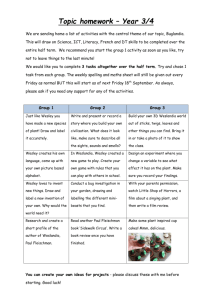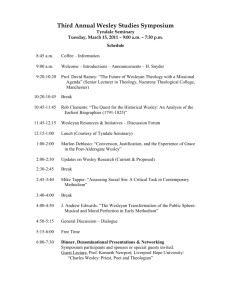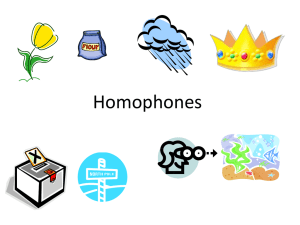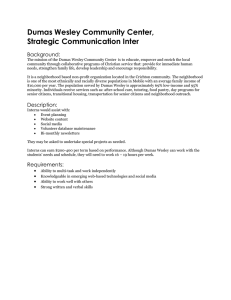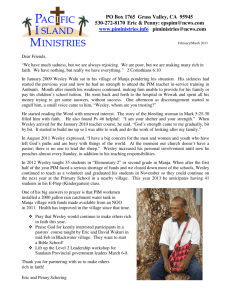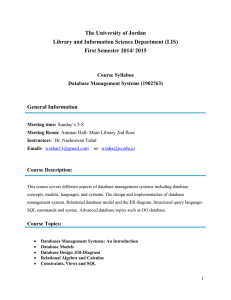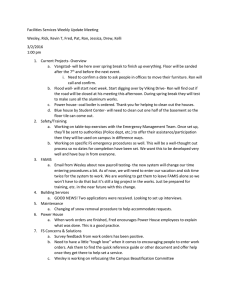john wesley`s publishing apprenticeship
advertisement
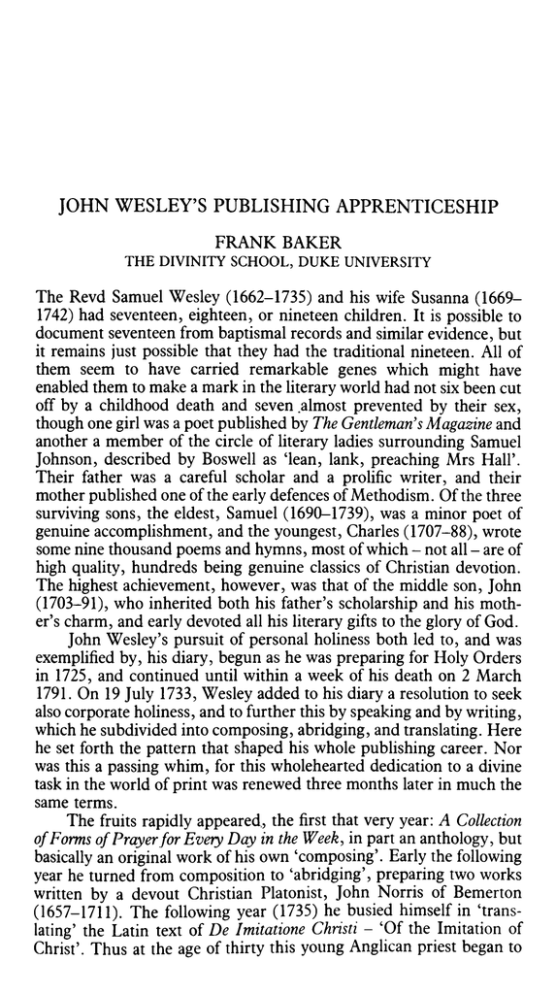
JOHN WESLEY'S PUBLISHING APPRENTICESHIP
FRANK BAKER
THE DIVINITY SCHOOL, DUKE UNIVERSITY
The Revd Samuel Wesley (1662-1735) and his wife Susanna (16691742) had seventeen, eighteen, or nineteen children. It is possible to
document seventeen from baptismal records and similar evidence, but
it remains just possible that they had the traditional nineteen. All of
them seem to have carried remarkable genes which might have
enabled them to make a mark in the literary world had not six been cut
off by a childhood death and seven .almost prevented by their sex,
though one girl was a poet published by The Gentleman's Magazine and
another a member of the circle of literary ladies surrounding Samuel
Johnson, described by Boswell as 'lean, lank, preaching Mrs Hall'.
Their father was a careful scholar and a prolific writer, and their
mother published one of the early defences of Methodism. Of the three
surviving sons, the eldest, Samuel (1690-1739), was a minor poet of
genuine accomplishment, and the youngest, Charles (1707-88), wrote
some nine thousand poems and hymns, most of which - not all - are of
high quality, hundreds being genuine classics of Christian devotion.
The highest achievement, however, was that of the middle son, John
(1703-91), who inherited both his father's scholarship and his mother's charm, and early devoted all his literary gifts to the glory of God.
John Wesley's pursuit of personal holiness both led to, and was
exemplified by, his diary, begun as he was preparing for Holy Orders
in 1725, and continued until within a week of his death on 2 March
1791. On 19 July 1733, Wesley added to his diary a resolution to seek
also corporate holiness, and to further this by speaking and by writing,
which he subdivided into composing, abridging, and translating. Here
he set forth the pattern that shaped his whole publishing career. Nor
was this a passing whim, for this wholehearted dedication to a divine
task in the world of print was renewed three months later in much the
same terms.
The fruits rapidly appeared,, the first that very year: A Collection
of Forms of Prayer for Every Day in the Week, in part an anthology, but
basically an original work of his own 'composing'. Early the following
year he turned from composition to 'abridging', preparing two works
written by a devout Christian Platonist, John Norris of Bemerton
(1657-1711). The following year (1735) he busied himself in 'translating' the Latin text of De Imitatione Christi - 'Of the Imitation of
Christ'. Thus at the age of thirty this young Anglican priest began to
72
BULLETIN JOHN RYLANDS LIBRARY
publish in the same three categories which continued to engage him
for fifty-eight years, during which period he and his brother Charles
sent forth some 450 works, ranging from the fifty volumes of A
Christian Library to a handful of four-page tracts and many circular
letters, as well as a miscellany of many sizes and subjects in between.
Altogether these passed through about two thousand editions during
his lifetime, or several million individual copies. Many complete
editions of two or three thousand copies, however, have been thumbed
into extinction, or are represented by single survivors in out-of-theway places.
On 15 March 1740, when he was 36, John Wesley answered an
inquiry about his publications by listing thirteen during the years
1733-39. He did not name, however, a work which probably did more
for the technical aspects of his career as scholar, editor, and publisher,
than any other of those early publications. This was his father's
Dissertationes in Librum Jobi - 'Dissertations on the Book of Job'. It
should be noted, however, that technical excellence is only one side of
Wesley's publishing story; the spiritual fire which energized his
literary task as prophet came to him through that remarkable experience of 24 May 1738, when he was twelve-and-a-half years into his
calling as a clergyman, and felt his heart 'strangely warmed'. 1
Samuel Wesley had been preoccupied with his work on Job for
half of his long life. In 1709 little Jacky Wesley was signally plucked
from the burning rectory, but his father's manuscripts, incorporating
immense labours on Job, all perished. At the time Mrs Wesley was
once more pregnant. Her husband's determination to begin again was
perhaps symbolically affirmed in the unusual name given to the
fire-child, Kezia - for this was the name of the second daughter born to
Job after his own fortunes were restored. Even Alexander Pope, who
in his Dunciad had disparaged Wesley's verse, acknowledged his
courageous labours, and secured Jonathan Swift's advocacy for Job. 2
Actually it was only during his declining years that Samuel Wesley
began again on his mammoth task, which overshadowed both his
family and his parish. Each of his three sons was drawn into this
project, notably John. Job coloured John Wesley's life at Oxford and
beyond, and furnished the text for his first published sermon. 3
. ' See John Wesley, Journal, 24 May 1738, sect. 14.
2 Pope wrote to Swift on 14 April 1730: 'It has been the labour of eight years of this learned
man's life; I call him what he is, a learned man, and I engage you will approve his prose more
than you formerly could his poetry'. The Correspondence of Alexander Pope, ed. George Sherburn
(5 vols., Oxford: Clarendon Press, 1956), III, 95; cf. The Correspondence ofJonathan Swift, ed. F
Elrington Bell (6 vols., London: G. Bell & Son, 1910-14), IV, 130-32, 142, 147.
3 A Sermon preached at St Mary's in Oxford, on Sunday, September 21, 1735 (London: for
Rivington, 1735). The text was Job 3:17: There the wicked cease from troubling, and there the
weary be at rest.'
WESLEY'S APPRENTICESHIP
73
Having been ordained deacon in 1725 and elected a Fellow of
Lincoln College, Oxford in 1726, in 1727 John Wesley went to serve
his father as curate in the parishes of Epworth and Wroot, until
recalled to his teaching duties at Oxford in 1729. Here he found that
his brother Charles had gathered together a tiny group of fellowstudents nicknamed 'Methodists'. Just before leaving Lincolnshire for
Oxford John Wesley shared a research tour with his father - a tour
dedicated to Job. This included four days spent at Wentworth House
in Yorkshire with Thomas Wentworth, Earl of Malton. They ate meals
with Lord Malton and worked with his chaplain in the magnificent
library; on Sunday, 26 October 1729, John Wesley preached in
Wentworth Church before his lordship and his own father.
Nor was this journey concerned only with research on Job, but
formed a part of the first major attempt to promote the actual
publication of Samuel Wesley's magnum opus., by means of printed
Proposals to publish five hundred copies. These were to be paid for by
advance subscriptions of a guinea, which in theory would pay the
printer's bills while sheet by sheet he prepared the work for delivery to
the subscribers. Before setting out John Wesley had numbered the
copies of the Proposals by hand, and on their journey father and son
secured a promising number of subscriptions;4 Lord Malton himself
paid for three large paper copies and two small. It was a copy of these
Proposals which in 1730 gained Alexander Pope's support.
There were still insufficient subscribers to underwrite the project,
however, and the following autumn Wesley's printer, William Bowyer, prepared a further thousand copies of the Proposals, as well as
seven hundred and fifty receipts for the prospective guineas advanced
by the subscribers. 5 On Wesley's behalf Bowyer also advertised the
work that winter in the London Evening Post. 6 The rector wrote to his
son Samuel on 17 December 1730, about his hopes of dedicating a
third work to a Queen of England, having heard that 'her Gracious
Majesty, Queen Caroline, ... is an encourager of learning'. He
added: 'And this work, I am sure, needs a royal encouragement,
whether or no it may deserve it.' But at the same time he made
contingency plans: 'If we have not subscriptions enough for the cuts
[i.e. engravings], as proposed, we must be content to lower our sails
again, and to have only the maps, the picture of Job, which I must
have at the beginning, and some few others.'7
Bowyer went ahead with printing the 'Prolegomena', outlining
the intended scope of the volume, and acknowledging the sources
4 At Wesley's Chapel, London, is a receipt made out by John Wesley (and shakily signed by
his father) for subscription No. Ill from the Revd Dr Goodwin, dated 24 October 1729.
5 MS Ledgers of William Bowyer (Grolier Society, New Yorki, I, 82.
6 Ibid., 12 Feb. 1731/2.
7 Adam Clarke, Memoirs of the Wesliy Family (2 vols., London: Tegg, 1844), I, 319-21.
74
BULLETIN JOHN RYLANDS LIBRARY
consulted and the help given, especially by his three sons. This was
circulated for critical comments. 8 Samuel Wesley now wrote grandly
about Job being 'in the press'9. In fact, little more appeared in print
for another three years, except that more subscribers' receipts
appeared in March 1731, five hundred more Proposals in August that
year, and then a slow unnoted trickle of proofs. Not until April 1734
were the final sheets of the Dissertations themselves printed off 10 and this was in fact only the first part of the advertised work, though
the largest.
Small wonder that Samuel Wesley received complaints from some
of his less patient subscribers. They knew nothing, however, of his
narrow escape from death on 4 June 1731, when he was run over by
the family wagon; of the lost use of his writing hand - partly as a result
of the accident; of his gout; and of his attempts to keep the parishes of
Epworth and Wroot in the family as his health steadily deteriorated.
He strove to remain cheerful, however, and perhaps used too much
jocularity in reminding the Revd Henry Piggot on 22 February 1733,
that long delays were 'common in books of this nature', and that the
patience of Job was needed by author and subscribers alike. He
insisted that the preparations were in the trustworthy hands of his son
Samuel in Westminster, and that he himself would visit London that
summer 'to push on the editing of it, by helping to correct the press
both in text and maps, and to frame the indexes'. 11
John also seems to have worked very hard, and was perhaps the
most successful in soliciting subscriptions for the work. On 28 April
1731, his older brother Samuel confessed to John: 'Great part of what I
should do I often let alone, though I am sorry for it afterwards.' He
went on to tell John that he had called on Dr Terry, Canon of Christ
Church, 'to desire him to subscribe to Job, but did not meet with him'
- yet when Terry called on him he did not have the heart to mention
Job! In the same letter he acknowledged the enrolling of twenty
subscribers by John. 12 John's diary reveals him in perpetual motion
from one task to another, and for five years much of his time was
dedicated to Job. Turning to his original diary of 1725-29, John used
some blank pages to list subscribers and potential subscribers, and to
record the distribution of the numbered Proposals and receipts. 13
8 Ibid., II, 419.
9 See his letter of 6-17 Feb. to John; Oxford/Bicentennial Edition of The Works of John
Wesley, Letters, 25: 720.
10 See Bowyer, Ledgers I, 82.
11 Clarke, Memoirs, I, 317-18.
12 'I have the names of twenty subscribers of yours, but not their titles and dignities' (Wesley,
Letters, 25: 278-79).
13 The diary contains a list of those 'possible' (with three of the names struck through), a note
of 'fifty rec(eip)ts from my brother Samuel, July 4, (17)30' Nos. 201-6 sent to Charles, 207-16 to
Mr. Daniel, and 'June 21, 1734, Sent to Mr. Morgan five, from 241 to 245'.
WESLEY'S APPRENTICESHIP
75
Research upon Job also took up much of John's time, and it
seems likely that many of the recondite books which he studied at
Oxford during the years 1725-35 were perused as a part of this service
to his father. A detailed comparison of his diaries with the footnoted
contents of Job may perhaps document this more fully, but two
examples may be given. On 19 December 1729, he drew his father's
attention to 'a sort of essay on the origin of evil' in Humphrey Ditton's
Discourse concerning the Resurrection ofJesus Christ (1714), and abstracted the argument for him - this was used on pp. 332-33. On 11
December 1730, he wrote to his father: 'A week or two ago I pleased
myself mightily with the hopes of sending you a full and satisfactory
solution of your great question, having at last procured the celebrated
treatise of Archbishop King, De Origine Mali ['On the Origin of
Evil']. This he followed up a month later with a summary of the
work. 14 The latter certainly, the former probably, were directly
related to Dissertation 39, 'On the Origin of Evil', pp. 302-12.
Another piece of grist for Samuel's mill was prepared by John
during 15-23 August 1732, when John's diary recorded eight sessions,
a total of eleven hours, as dedicated to 'Job'. These entries are
explained by his monthly summary, 'collected] Ro. Burhil's Commentary on Job'. This was a manuscript by Robert Burhill (15721641) on some problem passages in the book, which John Wesley had.
apparently arranged to have on loan from Corpus Christi College for
his own use in Lincoln College Library. Again we cannot tell without
much research how (if at all) this influenced the text of the Dissertationes. But Samuel Wesley was anxious to secure information on a
multiplicity of minor points - on p. 538 he even introduced the
flooding of the Isle of Axholme in December 1729 as an illustration of
Job 30:13 - and his eclecticism was greatly indebted to the alertness
and assiduity of his son John.
John even served as his father's major translator of his English
essays into scholarly Latin, as he hinted in a letter to Samuel Furly (18
February 1756): 'You may easily see what Latin I write by one of the
Dissertationes injobum' The implication is, of course, that almost any
one of the dissertations would do, but an extant letter of his father's (17
February 1730/1) specifically requested him to 'translate Job's Wife
into Latin.' 15
At last in 1734 the long-awaited volume was beginning to take
shape. On 1 April William Bowyer entered charges in his ledgers for
82 sheets, viz. pp. 1-328. A few days later, however, apparent disaster
struck. The only London-based member of the family, the oldest son,
14 Wesley, Letters, 25:240-2, 258, 264-7.
15 Wesley, Letters, 25:720; see Dissertation 26, 'De uxore Jobi', 220-1.
76
BULLETIN JOHN RYLANDS LIBRARY
Samuel, who was overseeing the publication, but had been ailing for a
year, moved from Westminster to the healthier climate of Devon, to
take charge of Blundell's School, Tiverton. John took over in
London. 16
One suspects, however, that with John at the helm, even working
from Oxford, the departure of Samuel was by no means an
unmitigated catastrophe. On 31 July Charles paid enthusiastic tribute
to the effectiveness of John's oversight, reporting to their brother
Samuel: The last week he passed at London, chiefly in consulting Mr
[William] Law about one of his pupils; but he found time, notwithstanding, to dispatch three sheets of Job while there, and still goes on
with much more expedition than my father did while upon the spot.' 17
Inevitably, in spite of the genuine progress, complaints were not
silenced, and Kezia Wesley wrote to John on 14 August 1734: 'Mr
Boyse desires to know if there is any hopes of his ever seeing Job.' 18
The rector, however, gratefully acknowledged the solid progress made
under John's supervision: This is to repeat my thanks for the care you
have taken about my Job ... By the account you give me of the press,
they must now have gotten to page 400 or upward.' 19
Publication was so advanced, indeed, that in September 1734 yet
another batch of five hundred Proposals was printed, and possibly a
few more subscribers hooked. In the meantime young Johnny
Whitelamb at Epworth was serving Samuel Wesley in various
capacities, as amanuensis, as curate, more recently as son-in-law, and
also as the engraver of some of the plates for Job. This latter task
Whitelamb and the rector performed (as the latter admitted) 'as well as
we could by the light of nature'. 20 The frontispiece, however, was
being prepared by an acknowledged artist, George Vertue (16841756), official engraver to the Society of Antiquaries. As if symbolically to link his own sufferings and patience with those of Job, the
rector had arranged that 'Job's Phiz' on the seated figure should be his
own. 21 Largely through his publisher friend Charles Rivington, John
Wesley had been introduced to another professional engraver, Benjamin Cole - who also supplied plates for his Imitatio Christi - and
16 Samuel Wesley was appointed to Tiverton on 10 April 1734 (Proceedings of the Wesley
Historical Society, XX, 1935-36, 110-11).
17 Original Letters by the Rev. John Wesley and his friends, ed. Joseph Priestley (Birmingham:
Pearson, 1791), 16.
18 At The Methodist Archives and Research Centre, The John Rylands University Library ot
Manchester.
19 Wesley, Letters, 25:393-4.
20 Ibid. Whitelamb was a local boy whom the rector had adopted, see Clarke, Memoirs, i,
21 In his letter of 27 August 1734, Samuel Wesley reported: 'I've likewise just had a letter from
Mr Vertue, that he's going on with Job's Phiz, and that 'twill be ready by that time the work is fit
for it.'
WESLEY'S APPRENTICESHIP
77
with his aid the quality of several of the home-made engravings was
greatly improved. 22
A further twenty-two sheets were printed off in September, up to
page 416, ending the Dissertations themselves, and embarking on the
first leaf of the far more trying collated Hebrew text. John Wesley's
involvement at this stage became even more marked, and is documented by his diaries. The first thing that he did on arriving in
London for a week in October was to visit Bowyer. He then went to
Epworth for a week, where he spent much time in transcribing at least
some of the thousands of errata amassed by his father. Back in Oxford,
Job continued to engage a major part of his attention; he even
persuaded the Vice-Chancellor to subscribe for a copy. On 10
December he wrote a letter turning down at great length his father's
plea that he should accept the Epworth living. 23 Possibly as a measure
of atonement, and as a proof that this refusal would not bring about
the shipwreck of poor Job, John turned with renewed energy to his
editorial tasks. Most of his time was now spent in correcting the
collated Hebrew text for the printer. After four days of doing little
else, at 3.0 p.m. on Thursday, 20 February 1735, he noted in his
diary, 'End Collation'. This was surely the occasion for his writing the
final inscription of the volume, in large capitals, appearing on p. 599:
GLORIA INTELLECTUM DATORI
LAUS DEO SEMPER.
Collationis Libri JOBI FINIS.
('Glory to the Giver of understanding. Praise to God for ever. The end
of the collation of the Book of Job.') Doubtless he would have
sympathized with a less formal paraphrase of his inscription: 'Thank
God that's over!' In later years he defended the book from critics, but
confessed: 'It certainly contains immense learning, but of a kind which
I do not admire.'24
On the following day, after spending four more hours in tidying
up other miscellaneous editorial chores, he entered in his diary, 'End
Job.'
At the beginning of April 1735 both John and Charles Wesley
returned to Epworth because their father's health was deteriorating
22 The Christian's Pattern: or, A Treatise of the Imitation of Christ. Written originally in Latin, by
Thomas a Kempis . . . Compared with the original, and corrected throughout, by John Wesley, MA.
(London: for C. Rivington, 1735). For this Cole prepared the frontispiece and all the plates,
facing pp. 1, 67, 106, 263, together with the frontispiece for the pocket edition. John Wesley
recorded a visit to Cole in his diary for 17 Dec. 1734. For>6 Cole prepared those facing pp. 155,
157, 278, 287, 248, 415 - some maps, together with the crocodile, the hippopotamus and the
horse.
23 Wesley, Letters, 25:397-410.
24 His letter of 11 Jan. 1785: Arminian Magazine (1785), 151.
78
BULLETIN JOHN RYLANDS LIBRARY
rapidly; on 25 April he died. Charles reported to their brother Samuel
in distant Devon: The fear of death he had entirely conquered, and at
last gave up his latest human desires of finishing Job, paying his debts,
and seeing you.'25
John carried on almost alone. By the end of August a further
forty-eight sheets (pp. 417-599) had been proofread, and most of them
printed off, as well as the title, the list of subscribers, and the summary
of contents. The 'Collationis Libri Jobi Finis' which appeared on page
599, however, turned out to be 'Finis' also for the volume as a whole.
The promised indexes,26 the appendix containing the thousands of
errata,27 the dissertations on Job's disease and several other subjects
referred to in advance in the footnotes, though never actually printed,
were abandoned28 - a fact which no one appeared to notice, or to have
noticed since. Financial problems undoubtedly loomed large in this
decision, but it seems clear that another major reason was that John
Wesley (along with his helper Charles) now had a much more urgent
task in Georgia, while their older brother was both poor in health and
too far removed from the scene of publishing activity. John was
determined to pay a last tribute to his father's memory, however,
while yet there was opportunity - for who knew whether he would
ever return from his overseas adventure? It must be a limited tribute,
however, and not the full work for which he himself, as well as his
father, had prepared such masses of material.
At least one large paper copy was hastily bound, with a special
title-page, dated 1735, but without the lists of subscribers and the
contents. This volume, its pages measuring 18" x 103/4", Wesley carried
for presentation to Queen Caroline at Kensington Palace on Sunday,
12 October 1735 - the day before he embarked for Georgia. On board
the Simmonds he briefly reported the event to his brother Samuel: 'I
presented Job to the Queen on Sunday, and had many good words and
smiles.'29
It is possible that a few other copies were prepared at the same
25 Priestley, Letters, 52.
26 Samuel Wesley, Jun., felt that he should have furnished the index promised in the
Prolegomena (p. 5), but gratefully followed the 'kindly positive' advice of a cousin who claimed
that his weak health made this impracticable (Wesley, Letters, 25:459, lines 12-20).
27 Samuel Wesley, Sen., had complained to John on 27 Aug. 1734 that the errors would 'swell
my Errata into an Appendix,' adding: 'I never yet saw a book of the same bulk printed with, I
think, the twentieth part of the faults that are in this, which I think amount to several thousands'
(Wesley, Letters, 25:394).
28 These include 'Job's Disease' (Prolegomena, p. 2), 'Birds' (Prolegomena, p. 2; cf. p. 76),
'Job's Couch' (p. 178), 'Pyramids' (pp. 136,141), 'Satan' (pp. 377,416), and 'Troglodytes' (pp.
107, 517).
29 Wesley, Letters, 25:444; cf. The Diaries of Thomas Wilson, ed. C.L.A. Linnell (London:
SPCK, 1964), 135: 'Sunday 12. At Kensington. Took leave of Mr Oglethorpe. Mr Wesley
presented her Majesty with his father's book on Job.' This presentation copy remains in the
King's Library in the British Library, London, with the call number, 8.h.7.
WESLEY'S APPRENTICESHIP
79
time, but only one other copy is at present known having the 1735
title-page, and this is torn as if for cancellation. 30 Those delivered to
the subscribers and available to the general public carry a more
elaborate title-page, dated 1736, together with a list of the 343
subscribers and the summary of the contents, 'Elenchus Dissertationum', which Bowyer had printed off in August 1735. In February
1736 Job was noticed in The Gentleman's Magazine, and was also
advertised in The London Magazine as for sale at '£1. 1 Is. 6d. in Sheets'
- i.e. unbound at one-and-a-half guineas rather than the one guinea
paid by the long-suffering subscribers.
Sufficient copies remained on hand after twenty years, however,
for John Wesley to attempt the somewhat difficult task of selling them
off to Methodists of a later generation, when Latin was even less of a
normal accomplishment. He first advertised it at the end of a 1759 list
of 'Books published by Mr John and Charles Wesley' as 'A Paraphrase
upon Job in Latin, 1/2 bd. & Lettered], £1. Is.' It continued to make
a faithful appearance in succeeding lists, though reduced in price to
15s., and was finally dropped from the first major list published after
Wesley's death.
This weighty folio volume contains almost half a million words,
mainly in Latin, but peppered with quotations and references in
Hebrew, Greek, and (occasionally) English, albeit mainly the English
of Matthew Tindal's version of Job, or of the Authorized Version. The
first two-thirds of the work comprise fifty-three dissertations covering
a multitude of subjects, from the normal historical, geographical,
literary, and theological background of the book to matters such as 'A
digression on the Magi seeking Christ' (No. 21), 'On the cardinal
points of the heavens' (No. 24), 'Constellations and Meteors' (No. 36),
'On the Origin of Evil' (No. 39), 'Zoroastrianism' (No. 42), and 'On
the recent method of interpreting the Scriptures' (No. 51). An
indication of the wide-ranging 'curious learning' to which the dissertations were devoted is given by the three longest: No. 47, 'On Balaam'
(24 pp.), No. 14 'Allusions in Job' (21 pp.), and No. 38, 'On
Behemoth and Leviathan' (i.e. the hippopotamus and the crocodile, of
which plates are given, 17 pp.) The remaining one-third was a massive
work of textual scholarship, the collation of the Masoretic text with
fifteen other versions, Arabic and Syriac, Greek, Latin, and even two
in English, as well as the Aramaic Targums, together with Wesley's
occasional conjectures about the original text and suggestions for
rendering it into modern English idiom. Of this part that great scholar
Adam Clarke maintained: 'It is one of the most complete things of the
30 World Methodist Museum, Lake Junaluska, North Carolina. This (like the Queen's
volume) is an incomplete presentation copy.
80
BULLETIN JOHN RYLANDS LIBRARY
kind that I have ever met with; and must be invaluable to any man
who may wish to read this book critically.'31
This arduous introduction into the world of academic publication, encompassing six years or more of active involvement in a
work whose hair-splitting scholarship was probably not congenial to
him at the time, and certainly not in later years, eventually proved of
immense value to John Wesley in his evangelical role of author-editorpublisher. From 1729 to 1734 he had worked alongside his father, had
accompanied him on a research trip, had shared the chores of
preparing and promoting the successive printed Proposals and receipts
for a subscription edition, and had eventually become its chief
organizer and promoter. He had translated essays into Latin for
publication, as later he was to translate other Latin publications for his
own edited works. On behalf of his father he had collated innumerable
texts in several languages, and had prepared outlines and extracts from
rare books and at least one unpublished major manuscript. Taking
control of the publishing end in London, he had negotiated with the
well-known printer, William Bowyer, and had been steered by his
publisher, Charles Rivington, to engage a reputable engraver, Benjamin Cole, to replace at least some of the amateur products of the
Epworth circle. He had undertaken gruelling sessions in reading the
proofs of a complex text in several languages. He had helped to
prepare voluminous errata - which were never printed. He had been
compelled to make weighty decisions about inclusion and exclusion, to
balance economic choices and to weigh filial devotion against spiritual
usefulness. Most of this he had accomplished while serving also as the
leader of an experimental group of young men at Oxford who were
dedicating themselves to holy living, Christian fellowship, and service
to the poor. He had formally presented a massive volume to the Queen
of England.
That the volume did not really sell, but was bought more as a
tribute to the workers and the reputed workmanship than for its
practical worth to a world which knew not Latin, does not diminish
the fact that to John Wesley (as to his brothers) it was a 'most sacred
legacy' from their father. 32 Nor were the immense and varied chores
undergone in nurturing it into print by any means wasted. They
endowed him with scholarly and technical expertise for sharing the
even more sacred legacy of the living Christian gospel with a needy
world. Multitudes who would never hear his personal proclamation of
God's saving and sustaining message did so and do so because John
Wesley thus became familiar with his most influential pulpit, the
printing-press.
31 Clarke, Memoirs, I, 330.
32 Wesley, Letters, 25:459.
